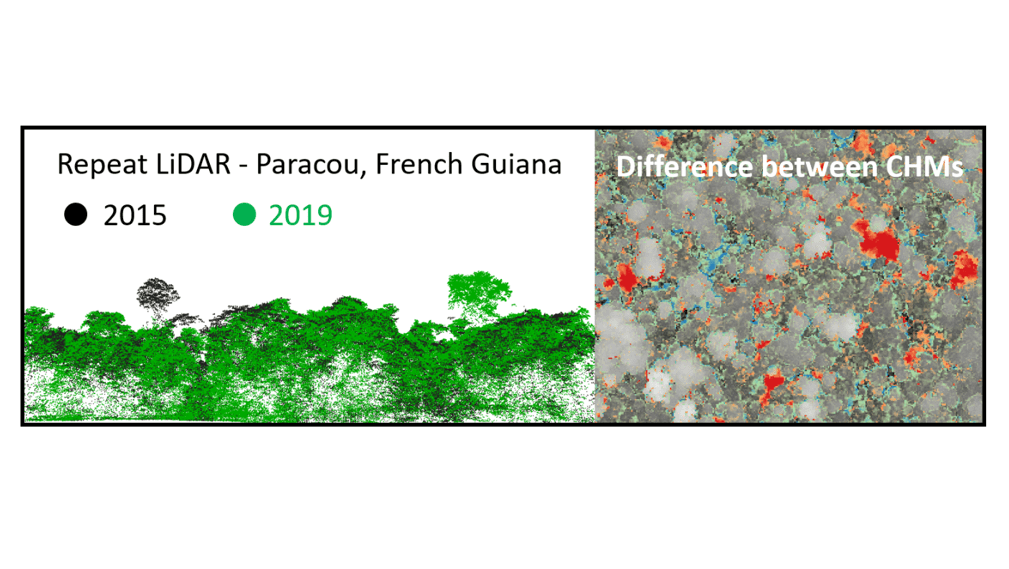We are bringing together repeat LiDAR data to study forest ecology at the global scale. We currently have over 40,000 ha of data across 11 countries. If you’d like to be part of this exciting project, please get in touch.
Repeat LiDAR is a powerful technique for monitoring forest dynamics over large spatial scales. We can now study growth and mortality at the landscape scale, with sufficient resolution to distinguish individual trees.
Aims:
1. Area-based change detection
Changes in forest structure are easily detected by subtracting two canopy height models collected > 1 year apart. Initially, we use spatial averages to determine whether canopy height has increased or decreased, corresponding to a gain or loss of carbon. These changes can then be compared with those detected in field data and related to environmental drivers and anthropogenic influences.
2. Gap dynamics and disturbance
Canopy gaps are the markers of forest disturbance and turnover rates, but they are usually observed at a single point in time. In this project we detect which gaps have been filled by fast-growing trees or lianas. We compare this to the number of new gaps and so compare whether disturbance rates with re-growth.
3. Large-tree mortality rates
The mortality rate of large trees is a key uncertainty in forest models and an important component of the terrestrial carbon cycle. Unlike field data, repeat LiDAR is well suited to study these rare events since the large trees are most easily detected and the spatial scales provide a good sample size. We delineate large trees in the initial LiDAR acquisition and use the subsequent LiDAR data to determine their mortality rates.
4. Individual tree growth rates
Tree growth is traditionally calculated using multiple diameter measurements. Measuring tree growth from the air is challenging, since tree crowns grow in complex ways according to their light environment. It also requires a shift in perspective since tree height growth may be poorly correlated with diameter growth for large trees. However, it is vital to get accurate estimates of tree growth rates in order to determine whether the carbon lost through disturbance is balanced by carbon accumulated through growth.
Current collaborators:
- David Burslem, University of Aberdeen
- Ruben Valbuena, University of Bangor
- Emily Lines, University of Cambridge
- Tommaso Jucker, University of Bristol
- Michele Dalponte, Fondazione Edmund Mach
- Grégoire Vincent, University of Montpellier
- Jérôme Chave, CNRS
- Maria Uriarte, Columbia University
- Douglas Morton, NASA Goddard Space Flight Centre
- Michael Keller, US Forest Service
- Laura Duncanson, University of Maryland
- Helene Muller-Landau, Smithsonian Tropical Research Institute
- Chris Philipson, Permian Global
- Eric Gorgens, Universidade Federal dos Vales do Jequitinhonha e Mucuri
- Erik Næsset, Norwegian University of Life Sciences
- Terje Gobakken, Norwegian University of Life Sciences
- Eliakimu Zahabu, Sokoine University of Agriculture, Tanzania
- Miłosz Mielcarek, Polish Forest Research Institute
- Krzysztof Stereńczak, Polish Forest Research Institute
If you would like to be part of this project please contact Dr Toby Jackson (tj312@cam.ac.uk), Professor David Coomes (dac18@cam.ac.uk) and Dr Matheus Nunes (matheus.nunes@helsinki.fi)
Data sharing policy:
We will not share data without the permission of the data providers. Data providers will retain ownership and will be offered co-authorship on publications which use their data.
If you would like to discuss this in detail or suggest additional data sharing policies please contact us.


Leave a comment